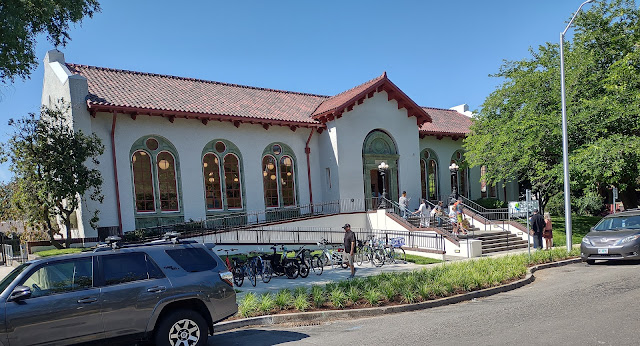 |
| Historic Carnegie branch on Knott Street |
There is much to admire about the new Albina branch library that just reopened after two years of remodeling and expansion.
Our focus here is primarily on preservation of the original
1912 Albina library that was funded by a donation by Andrew Carnegie. The wealthy industrialist paid for small
libraries built in neighborhoods, rather than for monstrosity buildings erected
in central cities. (He paid for seven in
Multnomah County; three remain as libraries today.)
Ellis Lawrence, who had a distinguished architectural career
over several decades in Portland and Eugene, was the original architect.
A team headed by Portland’s Lever Architecture has done an
outstanding job repairing the 11,000 square-foot Carnegie structure facing on
NE Knott Street while adding 30,000 square feet of new facilities facing a
block south on Russell Street.
 |
| New Albina branch entrance on Russell Street |
The Carnegie building has been totally devoted to children’s books and activities. Chandra Robinson, a Lever principal, said elderly Albina residents remembered going to the old library as children with their parents. She said the goal is to provide similar memories for children entering from Knott Street today.
Preservation of the old building included reopening three elegant interior arches that has been closed off in 1960 when the original library closed to the public. The work also included extensive work to improve earthquake protection.

Children's room. Note reopened arches, restored cornice moldings
The earthquake work meant destruction of the original
plaster cornice decorations.
Fortunately, Lever found an elderly plaster craftsman who was able to
reproduce them. The upshot is that a viewer familiar with the original building
will believe that nothing has changed.
Given the north-to-south slope of the block, walking through
a passageway at the rear of the Carnegie building brings one out on the second
floor of the big addition that faces on Russell Street. Extensive use of laminated timber beams and
large windows provide an open, airy feeling.
The new addition includes meeting rooms, reading rooms for adults
and teens, many comfortable seating options and an enclosed courtyard intended
to give a “back yard” feel.
----Fred Leeson





